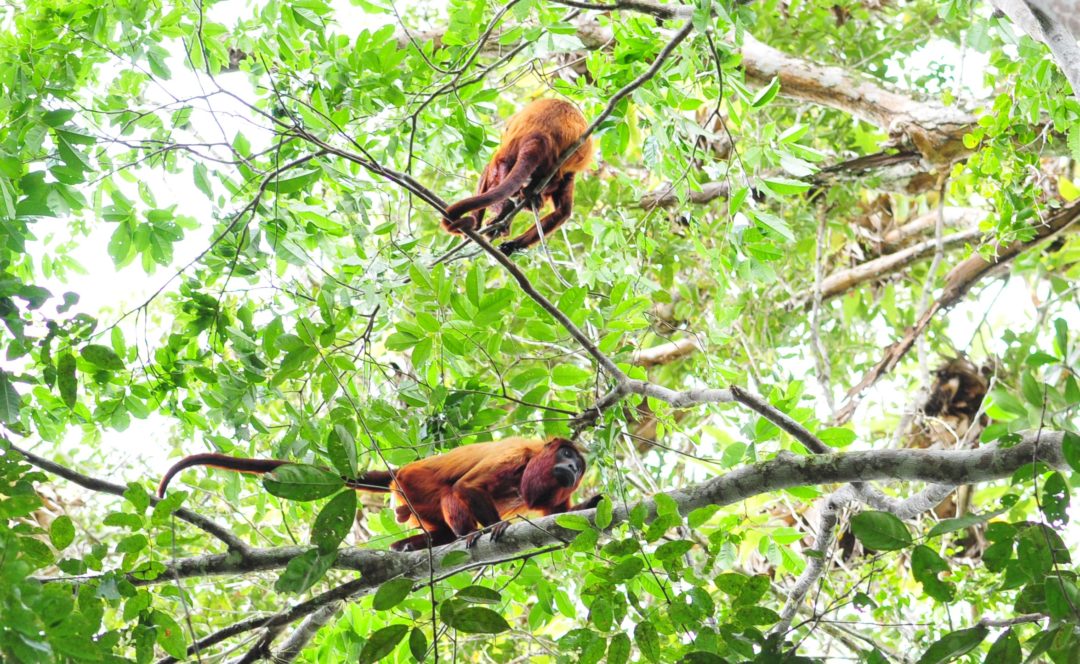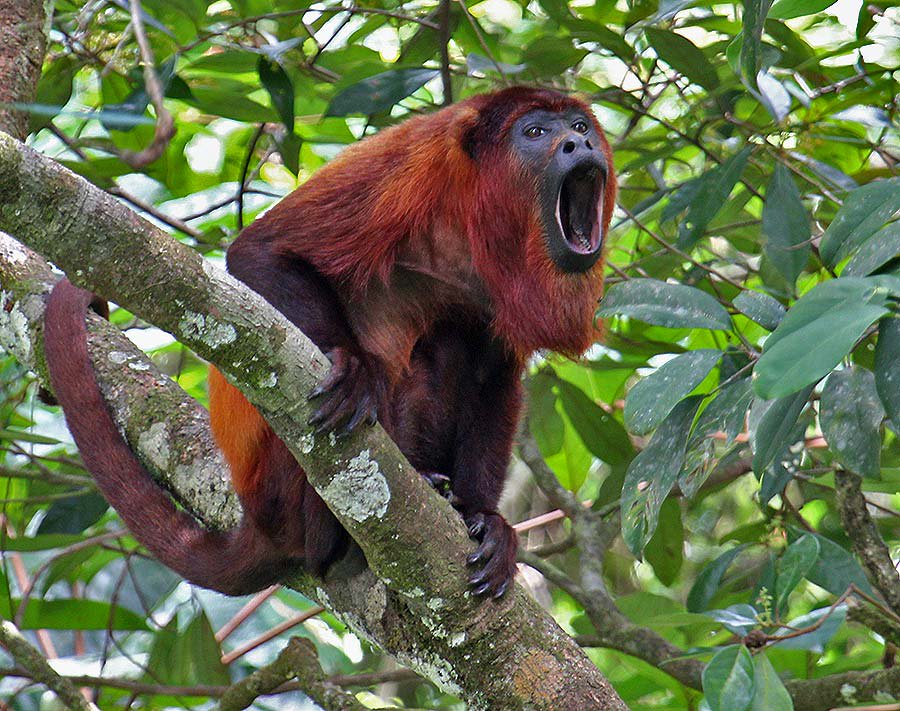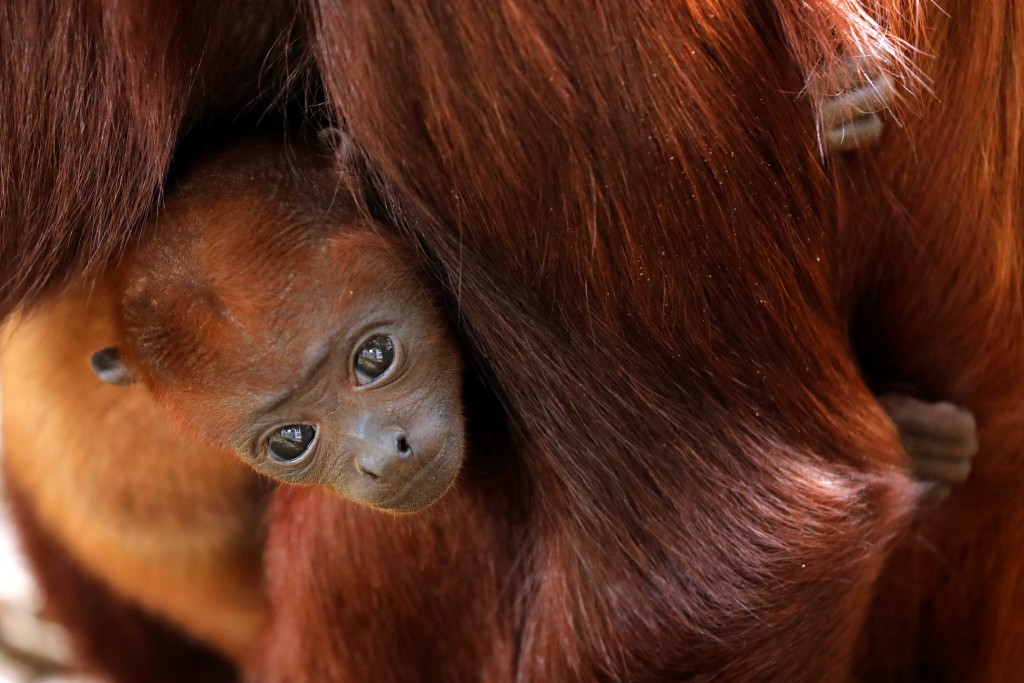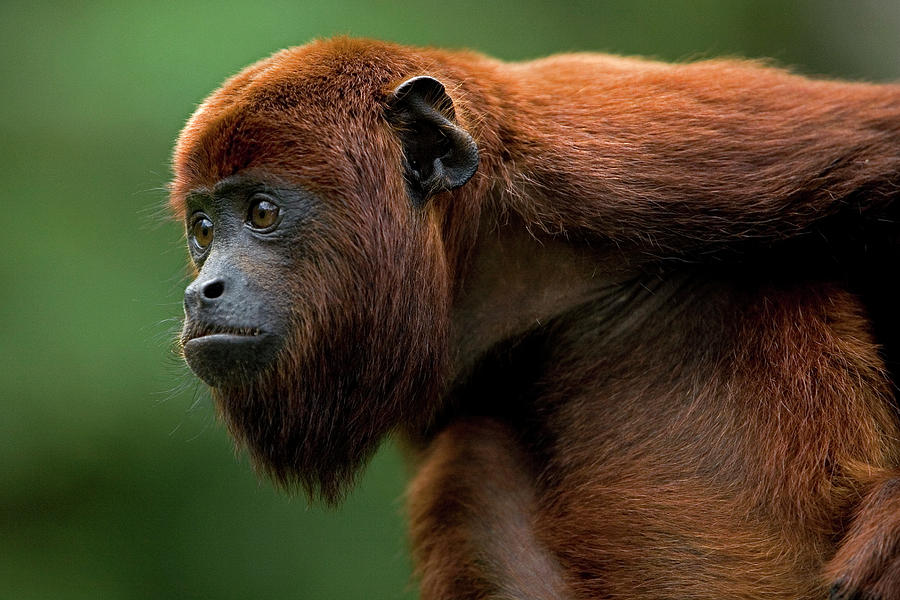
Red Howlers in the Trees
From the dense jungle to the lush savannas of the Rupununi, the deep bellowing growl of the Howler Monkey can be a majestic sound or be eerily frightening. They live up to their common name by howling. When a number of howlers let loose their lungs in concert, often early in the morning or at the end of the day, the uproar can be heard up to three miles away. Male monkeys have large throats and specialized, shell-like vocal chambers that help to turn up the volume on their distinctive call. The noise sends a clear message to other monkeys stating that this territory is already occupied by a troop and they need to stay away! Howler Monkeys are the largest New World monkeys, reaching heights of two to four feet.
The scientific name of a Howler Monkey is Alouatta. This mammal weighs up to 15 to 22 lbs. The Howler Monkey’s average life span in the wild lasts up to 15 to 20 years. They have large necks and jaws that allow them to create their loud vocalizations. They also boast a prehensile tail which can be used as an extra arm to grip or even hang from branches. A gripping tail is particularly helpful to Howler Monkeys because they rarely descend to the ground. They prefer to stay aloft, munching on the leaves that make up most of their diet. Generally, Howler Monkeys have beards and long, thick hair which may be black, brown, or red. Guyana is known for having the Red Howler Monkey.

The Howler
Types of Howlers
Fifteen species are currently recognized. 1/Black howler, 2/Mantled howler monkey, 3/Venezuelan red howler, 4/Brown howler, 5/Guatemalan black howler, 6/Red-handed howler, 7/Guyana red howler, 8/Bolivian red howler, 9/Coiba island howler, 10/Amazon black howler, 11/Ursine howler, 12/Purus red howler, 13/Maranhao red-handed howler, 14/Spix’s red-handed howler, 15/Jurua red howler.
Guyana – Land of the Red Howler Monkeys
Red howlers are the biggest of the howler monkeys. They have a thick, brownish to dark red fur, with gold or bright orange underparts, the color varying with the age and where the animal lives. The Howler’s dark face is surrounded by fur and their wide jaw is covered in a thick beard. They have a stubby nose and there is an enlarged hyoid bone in their mouth at the base of the tongue that causes the throat to look swollen. Their tails are also interesting, it is very long and without fur on the underneath of the last third, providing better grip for holding onto branches. The males are bigger and their beard is darker and heavier.
Howl of the Howlers
The howl of the Howler Monkeys sounds like a loud whooping bark or roar. It’s loud, distinct call sounds out its location to other family groups. When one group calls the others answer helping them to avoid direct contact. These animals live in groups called troops. They have small home ranges and spend very little time moving about. They’re usually hard to spot from the ground but can be seen quite easily from the river sitting in high riverside trees. They dislike rain, and howl when it is raining, sitting hunched over in trees.
Family of the Howlers

Family Life of the Howler: Image Source: https://www.popular-places.com/red-howler-monkey-suriname/
Their family groups are made up of males, females and the young. The leader is usually an old male. As they move about they stick together as a family and the troop is generally made up of five to nine individuals. The Howler Monkeys only have one offspring at a time. The female is usually pregnant for six months and after giving birth the infant will then stay with the mother for one and a half to two years. When the males become mature they are usually expelled from the group and have to invade another group to mate.
Red Howler Monkey Scientific Classification
- Kingdom: Animalia
- Phylum: Chordata
- Class: Mammalia
- Order: Primates
- Suborder: Haplorhini
- Infraorder: Simiiformes
- Family: Atelidae
- Genus: Alouatta
- Species: Alouatta macconnelli
Diet of the Howlers
 Howler Monkeys eat mainly top canopy leaves, together with fruit, buds, flowers, and nuts. They are also known to occasionally raid birds’ nests and chicken coops and consume the eggs. Howler Monkeys get almost all the water they need from the food they eat. During the dry season they may come to the ground at the river’s edge to drink and eat earth for minerals. Howler Monkeys are selective eaters, avoiding leaves that are poisonous or unsafe. They favor young tender leaves because they are easier to digest and has more protein and sugar.
Howler Monkeys eat mainly top canopy leaves, together with fruit, buds, flowers, and nuts. They are also known to occasionally raid birds’ nests and chicken coops and consume the eggs. Howler Monkeys get almost all the water they need from the food they eat. During the dry season they may come to the ground at the river’s edge to drink and eat earth for minerals. Howler Monkeys are selective eaters, avoiding leaves that are poisonous or unsafe. They favor young tender leaves because they are easier to digest and has more protein and sugar.
Home of the Howlers
Howler Monkeys live in Central and South America. They spend almost all of their time in the trees, and thus require a heavily-forested habitat with wide range of plant life. These monkeys can be found in a number of forested habitats, including tropical rainforests, evergreen forests and seasonal deciduous forests bordered by pockets of open savanna.
Mating habits and Infants of the Howlers
The female usually invites courtship by sticking out her tongue at a male. If there is no response, she approaches another male. Mating takes place throughout the year. Males are sexually mature after five years and females at four years old. Red howler monkeys are polygynous, usually one male mating with multiple females.
At one month, infants are able to use their tail to cling on to their mother, riding on her back, until they are one year old. Nursing lasts until the young are between eighteen and twenty-four months old.
Guyana’s Red Howler Monkey
To actually see a Howler Monkey in one of Guyana’s rainforest is a breath-taking experience. They are fast and high, moving from tree to tree, springing across the canopy. Seeing them jump as they use their tail as a fifth limb is eye catching. To spot that orange-red fur against the green lush forested background causes great excitement. That moment when they turn their black round face and look at you is thrilling. The Red Howler Monkey in Guyana is a sight that must definitely be seen.
References:
- Howler Monkey. “Guyana’s Red Howler”. https://en.wikipedia.org/wiki/Guyanan_red_howler
- “Alouatta macconnelli”. http://www.iucnredlist.org/details/40642/0
- “Red Howler Monkey”. http://www.wildinfo.net/facts/Redhowler.asp







